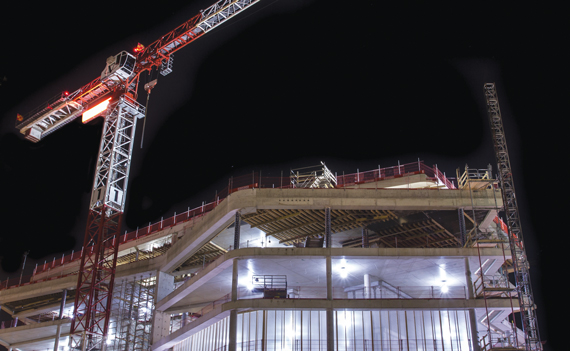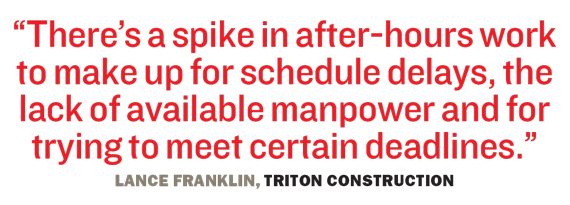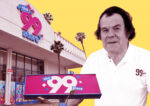Trending
The after-hours construction boom
Why buildings are rising on nights</br> and weekends

It’s Saturday morning and the alarm clock is silent — but thanks to a new luxury condominium next door, there’s the deafening roar of a pile driver slamming metal deep into the ground.
For many New Yorkers, this is an increasingly familiar occurrence. According to an analysis by The Real Deal, the city’s Department of Buildings has over the past three years seen a dramatic increase in the volume of after-hour work permits — defined as construction done before 7 a.m. or after 6 p.m. on weekdays or at any hour during the weekend. The number of permits in 2015 — 59,895 — represents a 90 percent spike from 2012, when 31,569 permits were issued. While more permits went toward minor renovations than new buildings —roughly 54.4 percent compared to 32.2 percent, respectively — the list included high-profile new projects like JDS Development Group’s 111 57th Street, Extell Development Company’s Central Park Tower and Vornado Realty Corporation’s 220 Central Park South.
Measured by borough, Manhattan led the list in 2015 with 35,753 permits, followed by Brooklyn with 13,215, Queens with 6,053, the Bronx with 3,744 and Staten Island with 1,125.
Workload demands
Experts attribute the upward shift to two major dynamics occurring in the city’s construction industry: a massive amount of new building and a shortage in skilled labor. The New York Building Congress estimates that construction spending will reach $41 billion in 2016 — the highest in the city’s history. And although employment in the industry is also on the rise (the Building Congress expects jobs to reach 131,800 in 2017), it isn’t growing fast enough to meet demand.
Under these pressure-cooker circumstances, some say that contractors and developers are exploiting the city’s after-work permitting system to get projects done as expeditiously as possible.
“I think it’s because there’s a lot of construction work, and the after-hour permits are needed because there’s actually a shortage of construction personnel,” said Lance Franklin, CEO of Manhattan-based Triton Construction. “There’s a spike in after-hours work to make up for schedule delays, the lack of available manpower and for trying to meet certain deadlines.”
Franklin said that his firm seeks these types of variances primarily for work on new buildings.
The high number of permits granted for renovations stems from the unpredictability of such projects, he said. Discoveries like an error in a floor plan or, say, asbestos behind a wall can create unforeseen delays and knock a project off schedule. “When you open something up, you never know what you’re going to find,” Franklin said. “The schedules are more challenging. You’re finding things that you’re not expecting.”
Similarly, an executive of another construction company, who asked not to be identified, said that the permits are not difficult to obtain and they go a long way in helping developers stay on schedule.
“It’s what the city allows, so you try to take advantage of what the city allows,” he said.
Murky reasons
In every borough except Staten Island, the top reason listed in 2015 was public safety. In Manhattan, 81 percent of the permits issued were for this reason.
 According to DOB representatives, the agency issues permits for five reasons: public safety, emergency work, undue hardship, construction that will cause minimal noise and city construction projects. However, based on TRD’s examination of hundreds of after-hours permits, the explanations provided are sometimes limited and don’t always spell out how the work qualifies as an act of public safety, often only indicating issues such as “traffic congestion” or “business hours.”
According to DOB representatives, the agency issues permits for five reasons: public safety, emergency work, undue hardship, construction that will cause minimal noise and city construction projects. However, based on TRD’s examination of hundreds of after-hours permits, the explanations provided are sometimes limited and don’t always spell out how the work qualifies as an act of public safety, often only indicating issues such as “traffic congestion” or “business hours.”
Alex Schnell, a DOB spokesman, said that permits issued for public safety serve as a “proactive safety measure” for work that “can’t be performed or would cause an unreasonable burden” during the weekday due to high levels of traffic. He noted that permits are a privilege that can be revoked.
After a spate of press and noise complaints, the DOB recently launched a “comprehensive evaluation” of how after-hour variances are issued. Schnell said the agency wanted to see if there were “alternative options that could be implemented without creating a danger to the public.”
When asked if the study was a response to the high volume of permits granted, Schnell would only say that it was an issue that DOB Commissioner Rick Chandler wanted to look into.
Apart from time, money is an obvious factor. Richard Lambeck, a clinical associate professor and chair of the construction management department at New York University’s Schack Institute of Real Estate, said the increase in after-hours permits highlights the growing prevalence of non-union construction in the city. Non-union workers, who by some estimates work on 50 percent of new construction in the city, are typically able to work nights and weekends without requiring overtime. In those cases, after-hours permits provide a less expensive avenue to getting the work done more quickly, he said. “The volume of work that is going on in New York City is just tremendous right now,” Lambeck said. “It’s using a lot of labor, and it’s using a lot of material, and the problem with this kind of environment is that you have trouble getting the workers you need to get it done.”
Cash cow
For the city, the after-hours permits have provided a growing stream of income. Applicants pay $80 per workday, plus an initial filing fee, which ranges from $100 (for one to three days of work) to $500 for 14 days. The city raked in $25.3 million in after-hour application fees in 2015, compared to $14 million in 2012, according to the DOB.
Over the last year, after-hours construction has received increasing attention. In 2014, Council Member Rosie Mendez, whose district includes the Lower East Side, the East Village and Gramercy Park, introduced a bill to set new standards for the permits, but the measure never made it out of committee. The bill is currently being amended and will likely be reintroduced before the end of the year. Council Member Dan Garodnick, one of the bill’s sponsors, said he and other council members are awaiting the results of the DOB’s study. “Nearly every Manhattan elected official called on the DOB to put down its rubber stamp and to start cracking down on unreasonable and illegal after-hours construction,” Garodnick said in a statement. “Developers feel entitled to these permits because of lax oversight and enforcement, and the results are quite painful for our communities.”




